Comparison of Phosphonium and Sulfoxonium Ylides in Ru(II)-Catalyzed Dehydrogenative Annulations: A Density Functional Theory Study
Abstract
1. Introduction
2. Results and Discussion
2.1. Reaction Mechanism and Free Energy Profiles
2.1.1. C–H Activation Process
2.1.2. Coupling and Annulation Processes
2.1.3. Overview of the Free Energy Variations
2.1.4. Explicit Solvation Effect
2.2. Structural, Energetic, and Wavefunction Analyses
2.2.1. Understanding the Distinctions Between A and B
2.2.2. Electronic Properties of Ruthenium–Carbene Intermediate
3. Materials and Methods
4. Conclusions
- The plausible catalytic cycles consist of several elementary steps, including C–H activation, ylide insertion, reductive elimination, protodemetallation, and an intramolecular Wittig reaction in succession, among which C–H activation is rate-determining, with a free energy barrier of 31.7 kcal/mol.
- In the proposed catalytic cycles, A serves as the substrate in the C–H activation step, and B is used as the carbene precursor in the insertion step. A comparison of the reactivities of A and B during the different steps resulted in the conclusion that A is kinetically more favorable in the C–H activation step than B, while the opposite conclusion is true for the insertion step. Therefore, it is understandable that the other competing pathways, including the homo-coupling reactions, can be effectively suppressed.
- Structural, energetic, and electronic analyses were carried out to deeply understand the observed results. The carbonyl group of A is a better directing group of C–H activation than that of B, while the -SOMe2 group of B is more labile than the -PPh3 group of A in the insertion step.
Supplementary Materials
Author Contributions
Funding
Institutional Review Board Statement
Informed Consent Statement
Data Availability Statement
Conflicts of Interest
References
- Rej, S.; Das, A.; Chatani, N. Strategic evolution in transition metal-catalyzed directed C-H bond activation and future directions. Coordin. Chem. Rev. 2021, 431, 213683. [Google Scholar] [CrossRef]
- Liao, J.; Kong, D.; Gao, X.; Zhai, R.; Chen, X.; Wang, S. Transition-metal-catalyzed directed C–H bond functionalization with iodonium ylides: A review of the last 5 years. Molecules 2024, 29, 3567. [Google Scholar] [CrossRef] [PubMed]
- Bisht, R.; Haldar, C.; Hassan, M.M.M.; Hoque, M.E.; Chaturvedi, J.; Chattopadhyay, B. Metal-catalysed C-H bond activation and borylation. Chem. Soc. Rev. 2022, 51, 5042–5100. [Google Scholar] [CrossRef]
- Sinha, S.K.; Guin, S.; Maiti, S.; Biswas, J.P.; Porey, S.; Maiti, D. Toolbox for distal C-H bond functionalizations in organic molecules. Chem. Rev. 2022, 122, 5682–5841. [Google Scholar] [CrossRef]
- Wu, K.; Lam, N.; Strassfeld, D.A.; Fan, Z.; Qiao, J.X.; Liu, T.; Stamos, D.; Yu, J.Q. Palladium(II)-catalyzed C-H activation with bifunctional ligands: From curiosity to industrialization. Angew. Chem. Int. Ed. 2024, 136, e202400509. [Google Scholar] [CrossRef]
- Kaltenberger, S.; van Gemmeren, M. Controlling reactivity and selectivity in the nondirected C-H activation of arenes with palladium. Acc. Chem. Res. 2023, 56, 2459–2472. [Google Scholar] [CrossRef]
- Su, B.; Hartwig, J.F. Development of chiral ligands for the transition-metal-catalyzed enantioselective silylation and borylation of C-H bonds. Angew. Chem. Int. Ed. 2022, 61, e202113343. [Google Scholar] [CrossRef] [PubMed]
- Nguyen, T.T.H.; Bosse, A.T.; Ly, D.; Suarez, C.A.; Fu, J.; Shimabukuro, K.; Musaev, D.G.; Davies, H.M. Diaryldiazoketones as effective carbene sources for highly selective Rh(II)-catalyzed intermolecular C-H functionalization. J. Am. Chem. Soc. 2024, 146, 8447–8455. [Google Scholar] [CrossRef]
- Zeng, Z.; Goebel, J.F.; Liu, X.; Gooßen, L.J. 2,2′-Biaryldicarboxylate synthesis via electrocatalytic dehydrogenative C-H/C-H coupling of benzoic acids. ACS Catal. 2021, 11, 6626–6632. [Google Scholar] [CrossRef]
- Pati, B.V.; Sagara, P.S.; Ghosh, A.; Mohanty, S.R.; Ravikumar, P.C. Ruthenium-catalyzed cross dehydrogenative annulation of N-(7-azaindole)benzamides with maleimides: One-step access to highly functionalized pyrroloisoquinoline. J. Org. Chem. 2021, 86, 6551–6565. [Google Scholar] [CrossRef]
- Liu, Y.; Roch, M.L.; Mori, A.; Pradal, A.; Poli, G.; Oble, J. Pd-Catalyzed [3+2]-dehydrogenative annulation reactions. Eur. J. Org. Chem. 2023, 26, e202300710. [Google Scholar] [CrossRef]
- Wu, Y.; Shi, G.; Liu, Y.; Kong, Y.; Wu, M.; Wang, D.; Wu, X.; Shang, Y.; He, X. A rhodium-catalyzed cascade C-H activation/annulation strategy for the expeditious assembly of pyrrolidinedione-fused 1,2-benzothiazines. Org. Biomol. Chem. 2024, 22, 3523–3532. [Google Scholar] [CrossRef] [PubMed]
- Singh, A.; Kumar, S.; Volla, C.M.R. α-Carbonyl sulfoxonium ylides in transition metal-catalyzed C-H activation: A safe carbene precursor and a weak directing group. Org. Biomol. Chem. 2023, 21, 879–909. [Google Scholar] [CrossRef] [PubMed]
- Hong, C.; Jiang, X.; Yu, S.; Liu, Z.; Zhang, Y. Recent Progress on the Application of Sulfoxonium Ylides in C-H Activation. Chin. J. Org. Chem. 2021, 41, 888–906. [Google Scholar] [CrossRef]
- Dethe, D.H.; Kumar, V.; Das, R. Ru(II)-Catalyzed C-H activation/[4+2] annulation of sulfoxonium ylide with maleimide: Access to fused benzo[e]isoindole-1,3,5-trione. Org. Lett. 2024, 26, 6830–6834. [Google Scholar] [CrossRef]
- Muthuraja, P.; Saeed Akhtar, M.; Gopinath, P.; Rok Lee, Y. Maleimide-controlled formation of indanonylpyrrolinediones and spiroindanonylpyrrolinediones via Rh(III)-catalyzed C-H activation of sulfoxonium ylides. Adv. Synth. Catal. 2023, 365, 4595–4602. [Google Scholar] [CrossRef]
- Hanchate, V.; Devarajappa, R.; Prabhu, K.R. Sulfoxonium ylide directed C-H activation and tandem [4+1] annulation. Org. Lett. 2020, 22, 2878–2882. [Google Scholar] [CrossRef]
- Kumar, A.; Sherikar, M.S.; Hanchate, V.; Prabhu, K.R. Application of sulfoxonium ylide in transition-metal-catalyzed C-H bond activation and functionalization reactions. Tetrahedron 2021, 101, 132478. [Google Scholar] [CrossRef]
- Karishma, P.; Agarwal, D.S.; Laha, B.; Mandal, S.K.; Sakhuja, R. Ruthenium catalyzed C-H acylmethylation of N-arylphthalazine-1,4-diones with α-carbonyl sulfoxonium ylides: Highway to diversely functionalized phthalazino-fused cinnolines. Chem. Asian J. 2019, 14, 4274–4288. [Google Scholar] [CrossRef]
- Zhang, Z.; Su, B.; Zhong, F.; Zhu, Y.; Zhou, Y.; Mai, S.; Tao, H. Ru(II)-Catalyzed carboamination of olefins with α-carbonyl sulfoxonium ylides. J. Org. Chem. 2024, 89, 5382–5391. [Google Scholar] [CrossRef]
- Chen, T.; Ding, Z.; Guan, Y.; Zhang, R.; Yao, J.; Chen, Z. Ruthenium-catalyzed coupling of α-carbonyl phosphoniums with sulfoxonium ylides via C-H activation/Wittig reaction sequences. Chem. Commun. 2021, 57, 2665–2668. [Google Scholar] [CrossRef] [PubMed]
- Park, J.E.; Kang, Y.K. Evidence of a Wheland intermediate in carboxylate-assisted C(sp2)-H activation by Pd(IV) active catalyst species studied via DFT calculations. Catalyst 2023, 13, 724. [Google Scholar] [CrossRef]
- Qi, X.; Lan, Y. Recent advances in theoretical studies on transition-metal-catalyzed carbene transformations. Acc. Chem. Res. 2021, 54, 2905–2915. [Google Scholar] [CrossRef]
- Wu, L.L.; Sheong, F.K.; Lin, Z.Y. DFT studies on copper-catalyzed dearomatization of pyridine. ACS Catal. 2020, 10, 9585–9593. [Google Scholar] [CrossRef]
- Zhang, L.; Li, S.; Wen, Y.; Ma, X.; Zhang, J.; Zhou, J.; Meng, X. DFT study on copper-catalyzed hydroboration of 1,3-diynes: Mechanism, selectivity, and comparison with ruthenium. Asian. J. Org. Chem. 2025, 14, e202400430. [Google Scholar] [CrossRef]
- Zhang, L.; Yu, L.; Zhou, J.; Chen, Y. Meta-selective C-H alkylation of 2-phenylpyridine catalyzed by ruthenium: DFT study on the mechanism and regioselectivity. Eur. J. Org. Chem. 2018, 2018, 5268–5277. [Google Scholar] [CrossRef]
- Ling, B.; Liu, Y.; Jiang, Y.-Y.; Liu, P.; Bi, S. Mechanistic insights into the ruthenium-catalyzed [4+1] annulation of benzamides and propargyl alcohols by DFT studies. Organometallics 2019, 38, 1877–1886. [Google Scholar] [CrossRef]
- Zhang, L.; Wang, L.-L.; Fang, D.-C. DFT case study on the comparison of ruthenium-catalyzed C-H allylation, C-H alkenylation, and hydroarylation. ACS Omega 2022, 7, 6133–6141. [Google Scholar] [CrossRef]
- Kozuch, S.; Shaik, S. A combined kinetic-quantum mechanical model for assessment of catalytic cycles: Application to cross-coupling and Heck reactions. J. Am. Chem. Soc. 2006, 128, 3355–3365. [Google Scholar] [CrossRef]
- Kozuch, S.; Shaik, S. Kinetic-Quantum chemical model for catalytic cycles: The Haber-Bosch process and the effect of reagent concentration. J. Phys. Chem. A 2008, 112, 6032–6041. [Google Scholar] [CrossRef]
- Domingo, L.R. Molecular Electron Density Theory: A modern view of reactivity in organic chemistry. Molecules 2016, 21, 1319. [Google Scholar] [CrossRef] [PubMed]
- Sadowski, M.; Dresler, E.; Wróblewska, A.; Jasiński, R. A new insight into the molecular mechanism of the reaction between 2-methoxyfuran and ethyl (Z)-3-phenyl-2-nitroprop-2-enoate: An Molecular Electron Density Theory (MEDT) computational study. Molecules 2024, 29, 4876. [Google Scholar] [CrossRef]
- Bader, R.F.W. Atoms in Molecules: A Quantum Theory; Oxford University Press: Oxford, UK, 1990. [Google Scholar]
- Yu, J.; Su, N.Q.; Yang, W. Describing chemical reactivity with frontier molecular orbitalets. JACS Au 2022, 2, 1383–1394. [Google Scholar] [CrossRef] [PubMed]
- Frisch, M.J.; Trucks, G.W.; Schlegel, H.B.; Scuseria, G.E.; Robb, M.A.; Cheeseman, J.R.; Scalmani, G.; Barone, V.; Mennucci, B.; Petersson, G.A.; et al. Gaussian 09, Revision A.02; Gaussian, Inc.: Wallingford, CT, USA, 2009. [Google Scholar]
- Becke, A.D. Density functional theochemistry. III The role of exact exchange. J. Chem. Phys. 1993, 98, 5648–5652. [Google Scholar] [CrossRef]
- Stephens, P.J.; Devlin, F.J.; Chabalowski, C.F.N.; Frisch, M.J. Ab initio calculation of vibrational absorption and circular dichroism spectra using density functional force fields. J. Phys. Chem. A 1994, 98, 11623–11627. [Google Scholar] [CrossRef]
- Becke, A.D. Density-functional exchange approximation. Phys. Rev. B 1988, 37, 785–789. [Google Scholar]
- Grimme, S. Semiempirical GGA-type density functional constructed with a long-range dispersion correction. J. Comput. Chem. 2006, 27, 1787–1799. [Google Scholar] [CrossRef] [PubMed]
- Grimme, S.; Antony, J.; Ehrlich, S.; Krieg, H. A consistent and accurate ab initio parametrization of density functional dispersion correction (DFT-D) for the 94 elements H-Pu. J. Chem. Phys. 2010, 132, 154104. [Google Scholar] [CrossRef]
- Weigend, F.; Ahlrichs, R. Balanced basis sets of split valence, triple zeta valence and quadruple zeta valence quality for H to Rn: Design and assessment of accuracy. Phys. Chem. Chem. Phys. 2005, 7, 3297–3305. [Google Scholar] [CrossRef]
- Weigend, F. Accurate Coulomb-fitting basis sets for H to Rn. Phys. Chem. Chem. Phys. 2006, 8, 1057–1065. [Google Scholar] [CrossRef]
- Grimme, S. Supramolecular binding thermodynamics by dispersion-corrected density functional theory. Chem. Eur. J. 2012, 18, 9955–9964. [Google Scholar] [CrossRef]
- Fukui, K. The path of chemical reactions-the IRC approach. Acc. Chem. Res. 1981, 14, 363–368. [Google Scholar] [CrossRef]
- Hratchian, H.P.; Schlegel, H.B. Using Hessian updating to increase the efficiency of a Hessian based predictor-corrector reaction path following method. J. Chem. Theory Comput. 2005, 1, 61–69. [Google Scholar] [CrossRef] [PubMed]
- Scalmani, G.; Frisch, M.J. Continuous surface charge polarizable continuum models of solvation. I. General formalism. J. Chem. Phys. 2010, 132, 114110. [Google Scholar] [CrossRef]
- Zhang, J.; Lu, T. Efficient evaluation of electrostatic potential with computerized optimized code. Phys. Chem. Chem. Phys. 2021, 23, 20323–20328. [Google Scholar] [CrossRef] [PubMed]
- Dapprich, S.; Frenking, G. Investigation of donor-acceptor interactions: A charge decomposition analysis using fragment molecular orbitals. J. Phys. Chem. 1995, 99, 9352. [Google Scholar] [CrossRef]
- Lu, T.; Chen, F. Multiwfn: A multifunctional wavefunction analyzer. J. Comput. Chem. 2012, 33, 580–592. [Google Scholar] [CrossRef]
- Lu, T. A comprehensive electron wavefunction analysis toolbox for chemists, Multiwfn. J. Chem. Phys. 2024, 161, 082503. [Google Scholar] [CrossRef]
- Legault, C.Y. CYLView, 1.0b; Universite de Sherbrooke: Quebec City, QC, Canada, 2009. [Google Scholar]

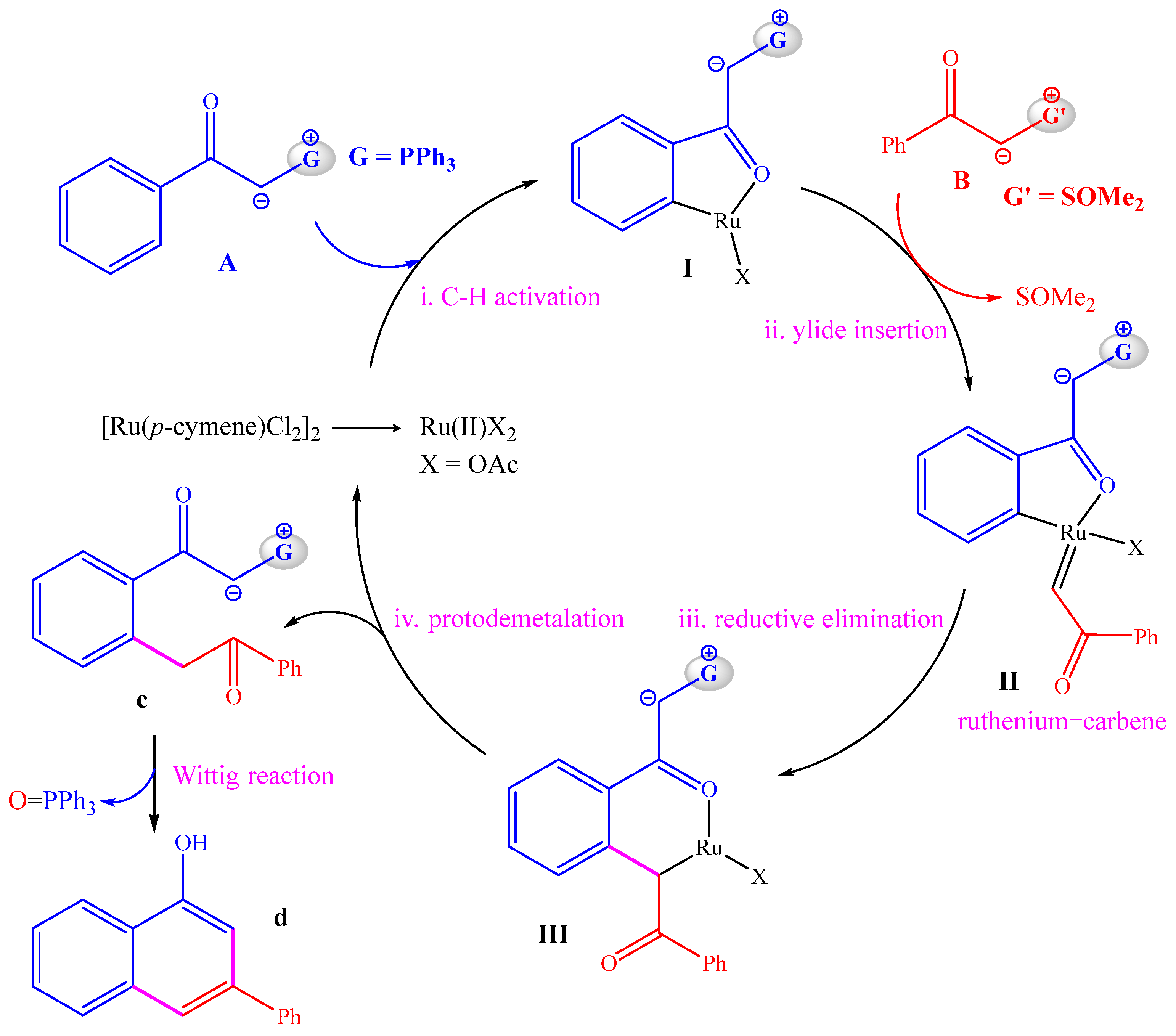
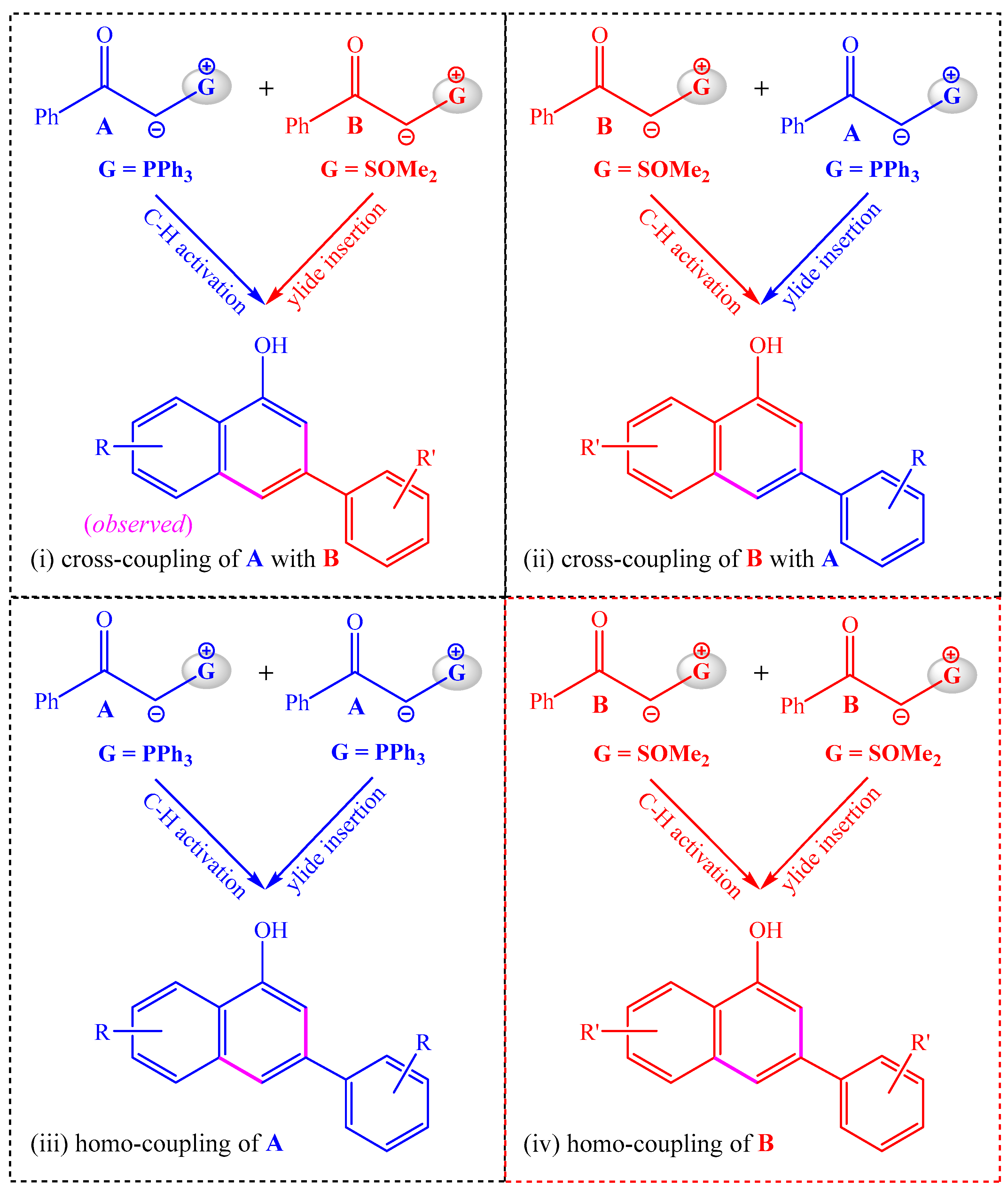

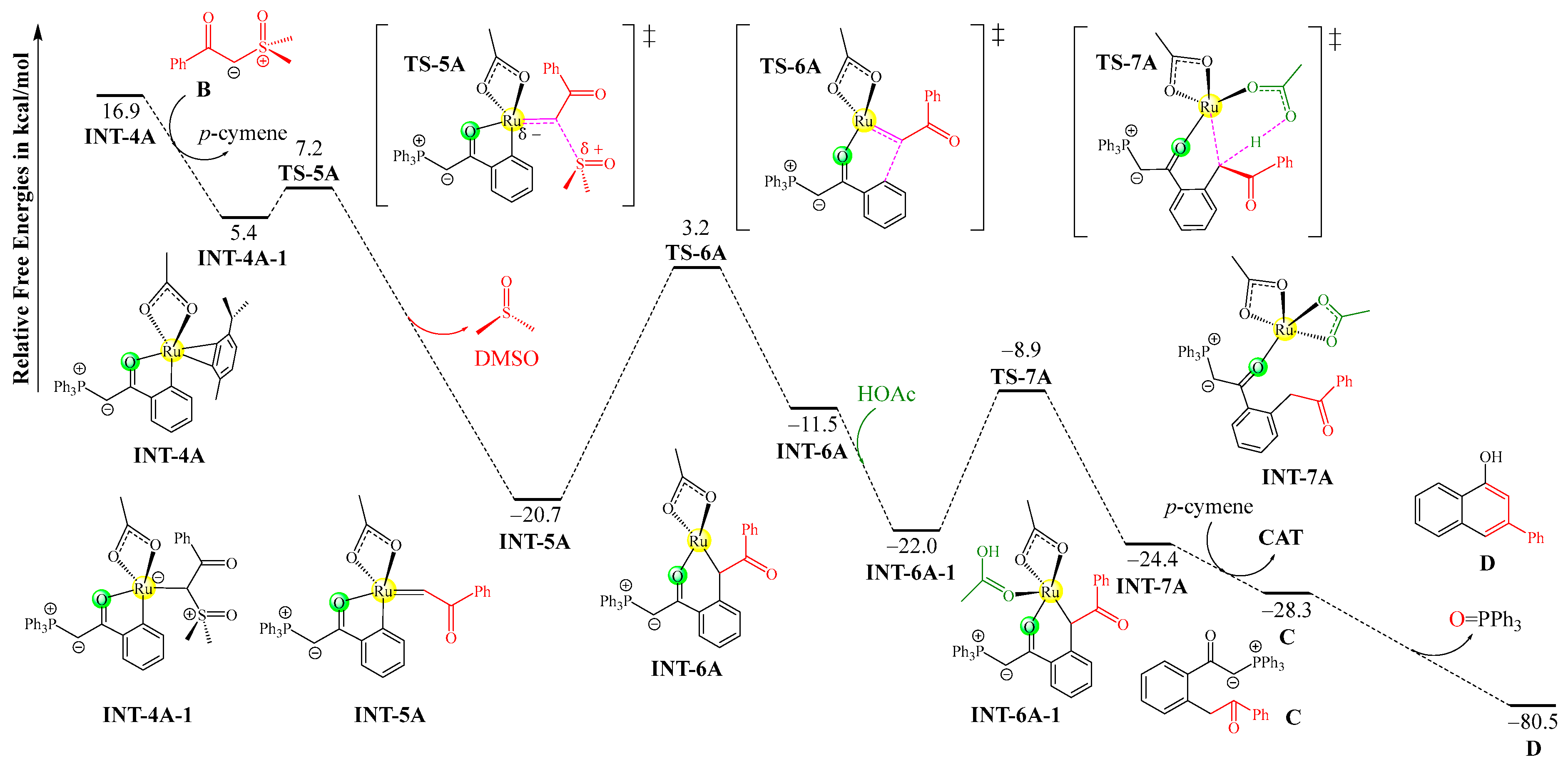

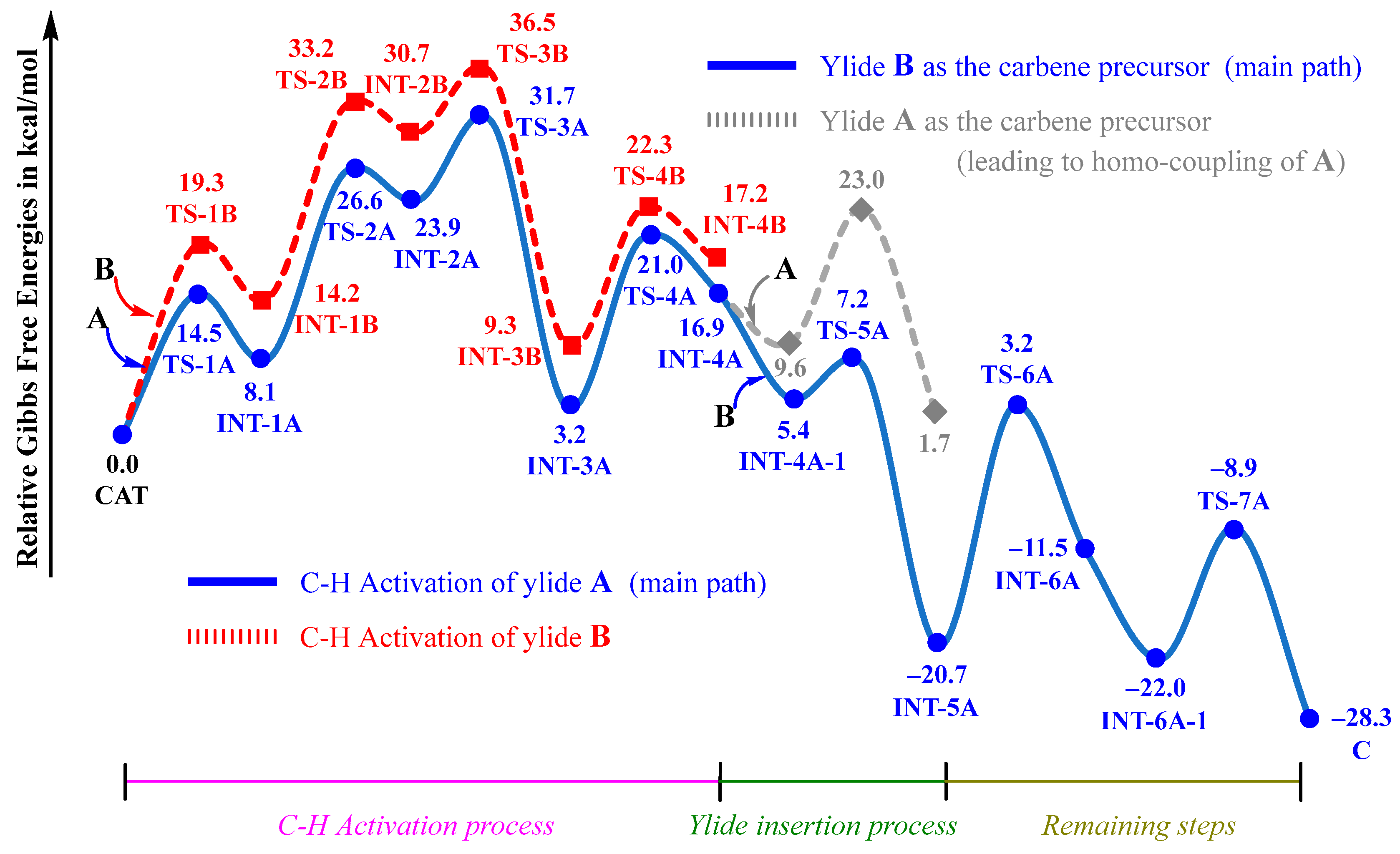
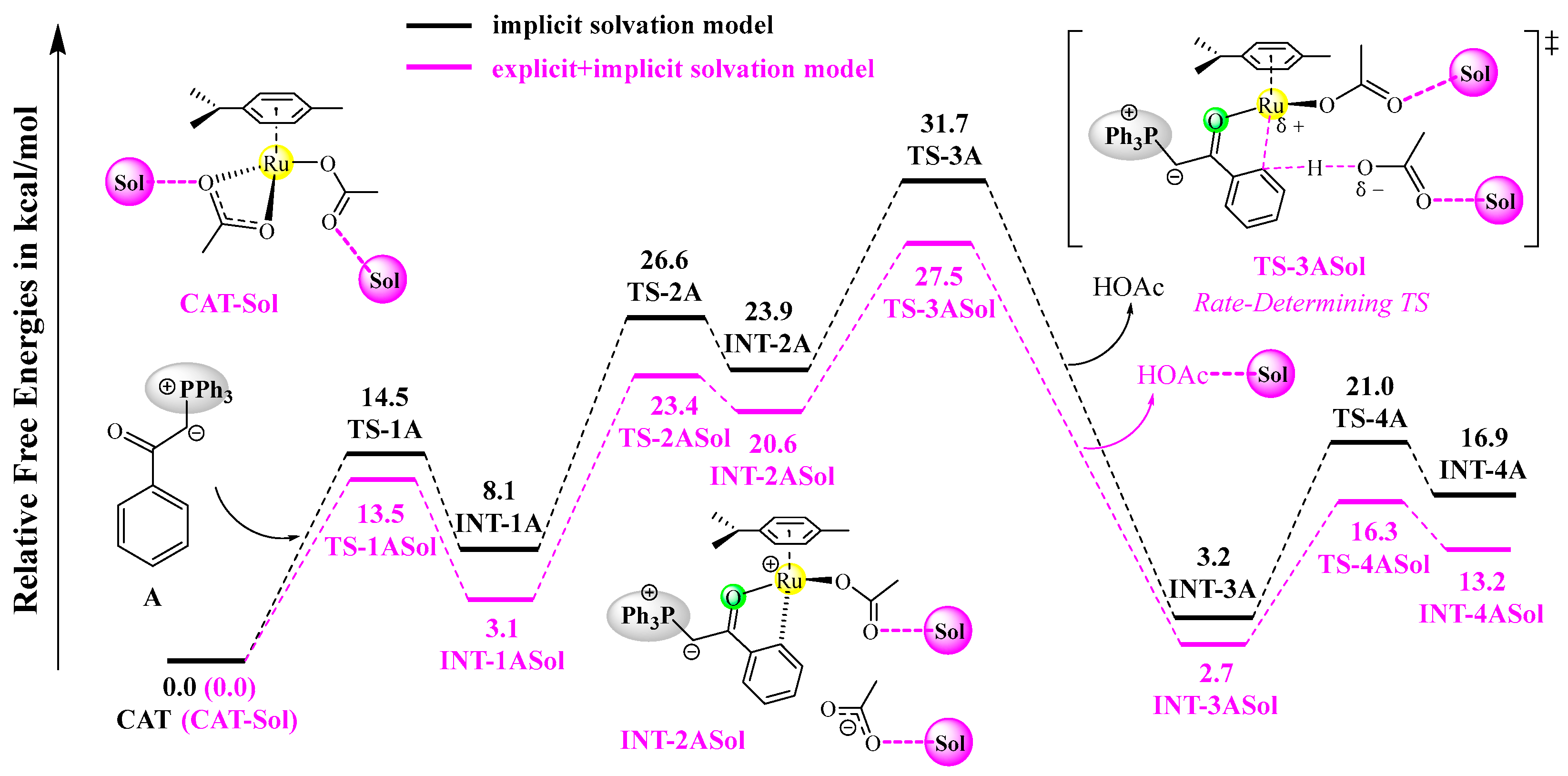

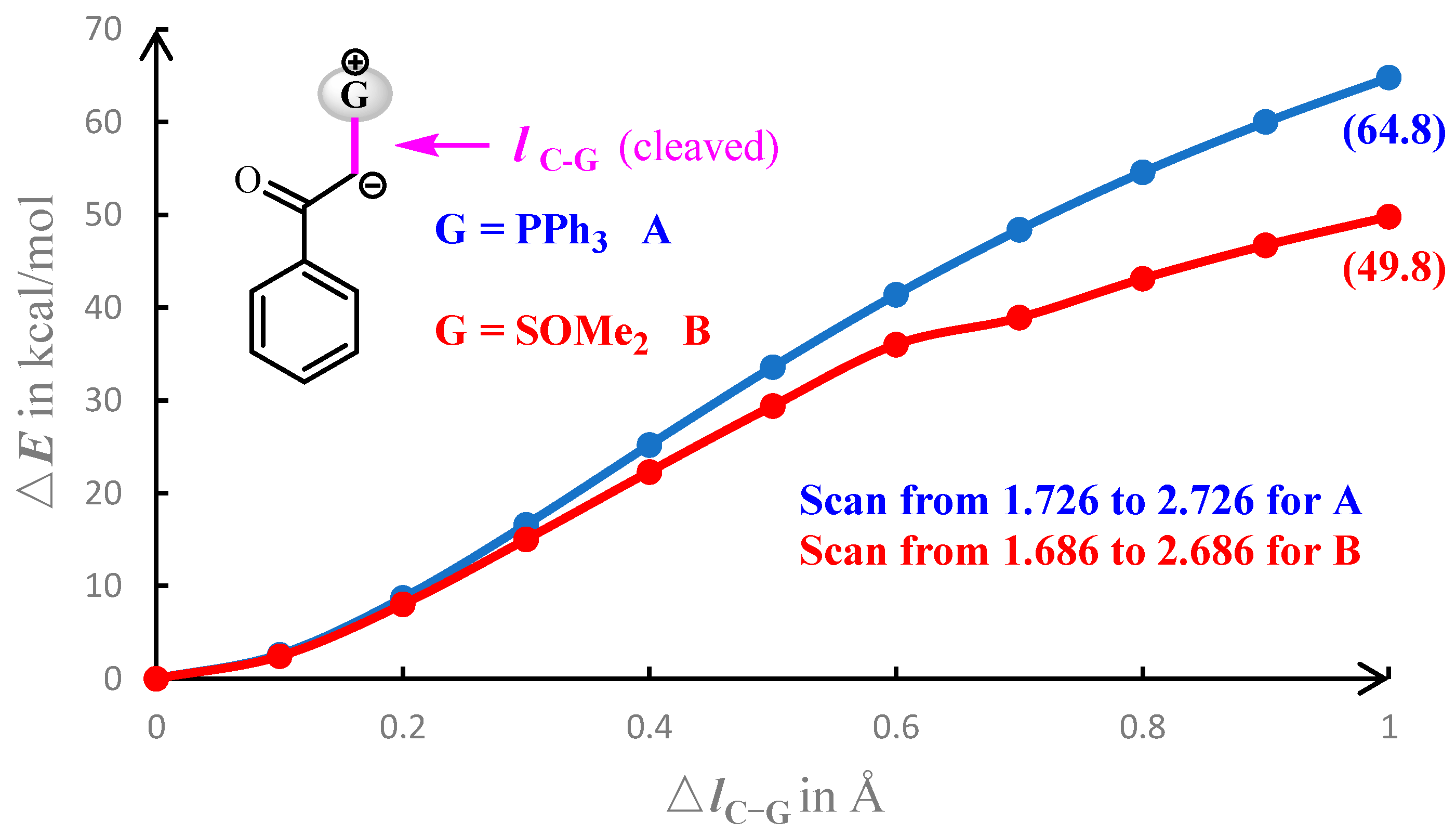
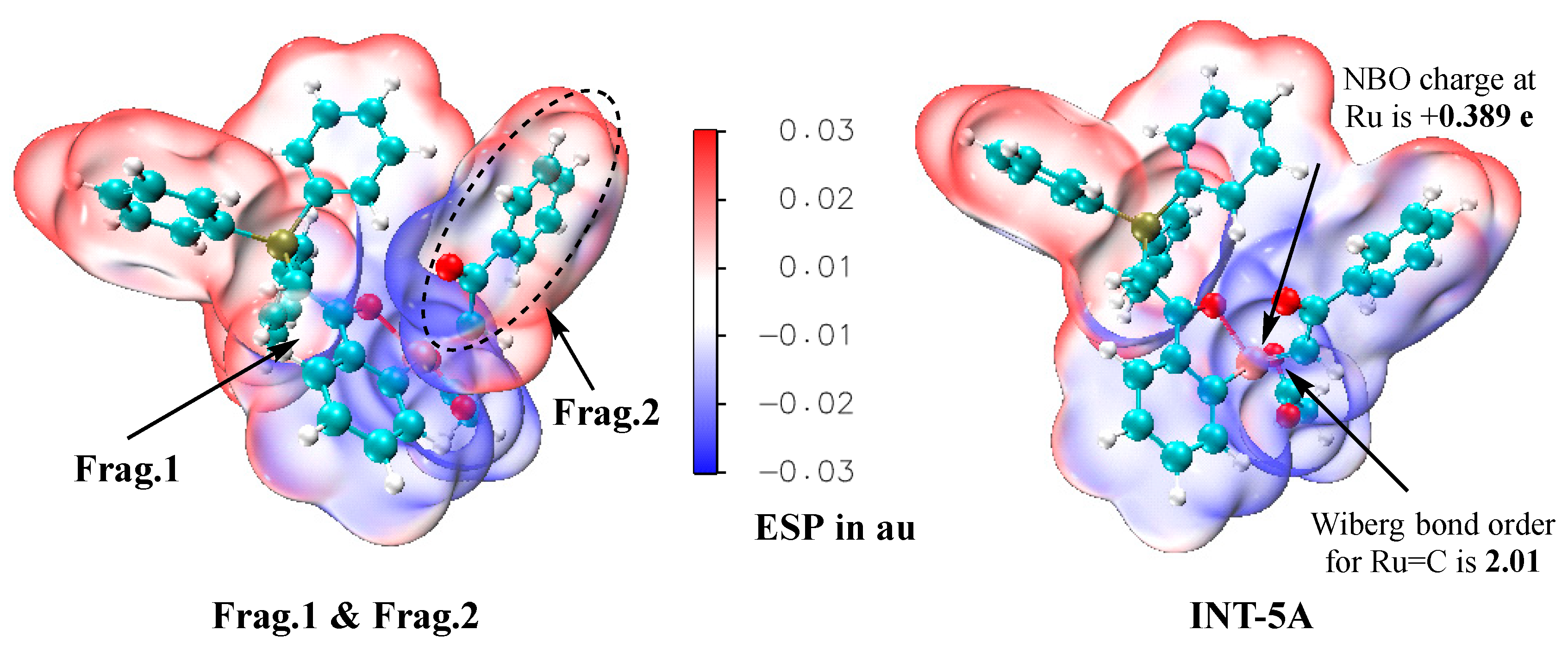
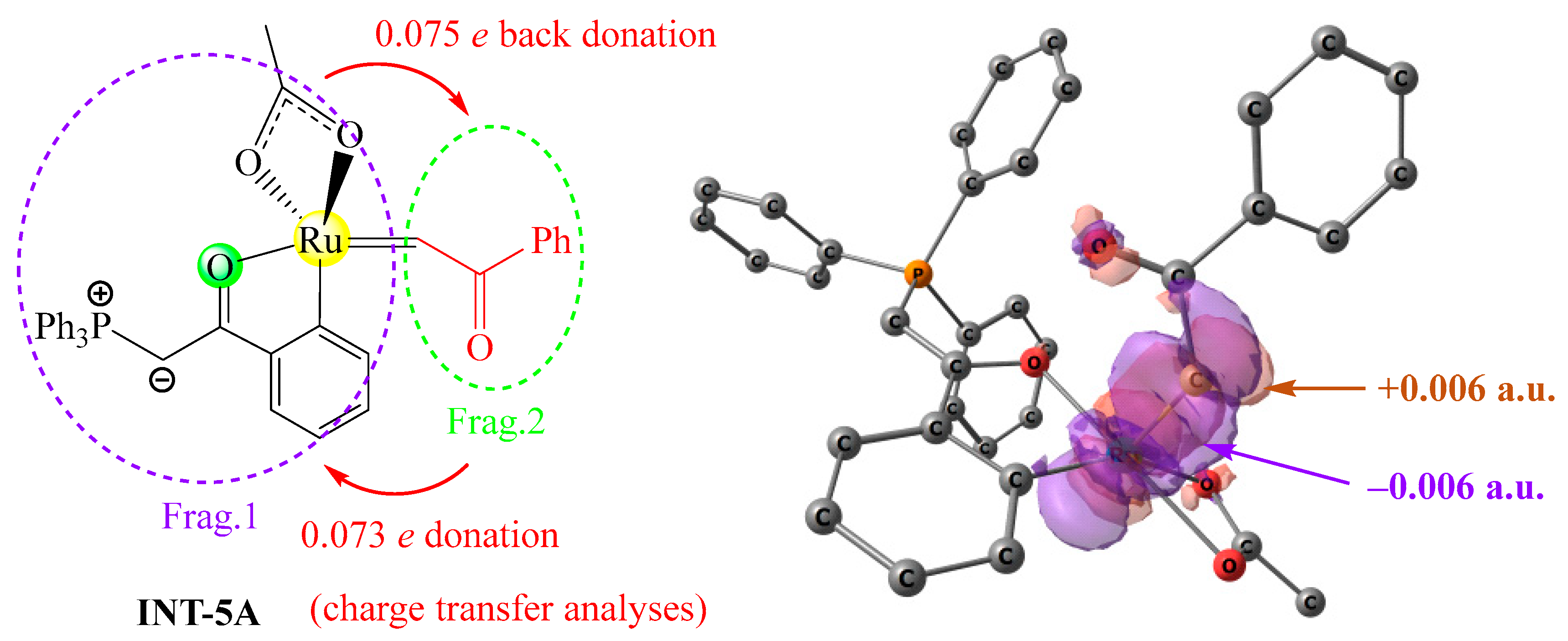
Disclaimer/Publisher’s Note: The statements, opinions and data contained in all publications are solely those of the individual author(s) and contributor(s) and not of MDPI and/or the editor(s). MDPI and/or the editor(s) disclaim responsibility for any injury to people or property resulting from any ideas, methods, instructions or products referred to in the content. |
© 2025 by the authors. Licensee MDPI, Basel, Switzerland. This article is an open access article distributed under the terms and conditions of the Creative Commons Attribution (CC BY) license (https://creativecommons.org/licenses/by/4.0/).
Share and Cite
Zhou, W.; Zhang, L.; Liu, D.-Y.; Ma, X.; Zhang, J.; Kang, J. Comparison of Phosphonium and Sulfoxonium Ylides in Ru(II)-Catalyzed Dehydrogenative Annulations: A Density Functional Theory Study. Molecules 2025, 30, 1883. https://doi.org/10.3390/molecules30091883
Zhou W, Zhang L, Liu D-Y, Ma X, Zhang J, Kang J. Comparison of Phosphonium and Sulfoxonium Ylides in Ru(II)-Catalyzed Dehydrogenative Annulations: A Density Functional Theory Study. Molecules. 2025; 30(9):1883. https://doi.org/10.3390/molecules30091883
Chicago/Turabian StyleZhou, Wei, Lei Zhang, Dan-Yang Liu, Xiaosi Ma, Jie Zhang, and Jiajia Kang. 2025. "Comparison of Phosphonium and Sulfoxonium Ylides in Ru(II)-Catalyzed Dehydrogenative Annulations: A Density Functional Theory Study" Molecules 30, no. 9: 1883. https://doi.org/10.3390/molecules30091883
APA StyleZhou, W., Zhang, L., Liu, D.-Y., Ma, X., Zhang, J., & Kang, J. (2025). Comparison of Phosphonium and Sulfoxonium Ylides in Ru(II)-Catalyzed Dehydrogenative Annulations: A Density Functional Theory Study. Molecules, 30(9), 1883. https://doi.org/10.3390/molecules30091883






